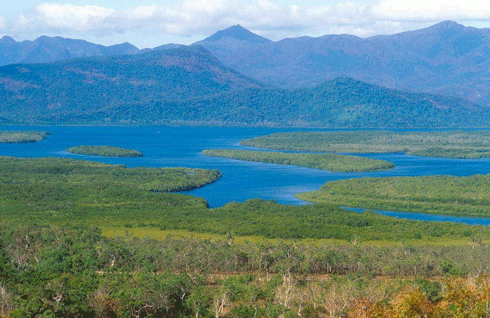
|
Published: 4 March 2013
New research into Australia’s ‘blue carbon’ potential
CSIRO is leading a new national research program to understand the role of Australia’s coastal and marine wetlands in storing atmospheric carbon dioxide.

|
|
Blue carbon bank? Hinchinbrook Island, channel and mangroves, as seen from lookout near Cardwell, Queensland. Credit:
CSIRO
|
Blue carbon is maintained for thousands of years, whereas terrestrial forest soils can become carbon-saturated relatively quickly and can release carbon during forest fires.
Understanding the important role of Australia’s coastal and marine wetlands in storing atmospheric carbon dioxide is the focus of a new $3 million collaborative research program headed by CSIRO. We are partnering with eight tertiary institutions, including the University of Technology, Sydney (UTS).
Over the next three years, the CSIRO Marine and Coastal Biogeochemistry Carbon Cluster – or Coastal Carbon Cluster – will create new models to collect information on blue carbon, a term used to refer to the capture and storage of atmospheric carbon in the marine environment.
It will be Australia’s largest ever blue carbon accounting, mapping and measurement study, according to CSIRO researcher, Andy Steven.
‘Understanding the importance of blue carbon to Australia’s ecosystems and economy is of national significance, yet currently our knowledge and estimates of national coastal carbon stocks are limited’, Steven said.
‘Protecting and restoring coastal marine environments to store atmospheric carbon can prove more economical than forest regrowth and can boost fishery and tourism industries.’
There are clear advantages to the use of coastal vegetation in the fight to reduce global greenhouse gas emissions. Seagrass, mangroves and saltmarsh capture carbon up to 100 times faster than forests and store it for thousands of years.
Australia’s coast nurtures a large proportion of the world’s seagrass and mangrove forests, but many of these have been damaged in the past. Conserving and restoring our coastal habitats is a cost-effective way to mitigate climate change by rebuilding carbon sinks, while delivering valuable ecosystem services to society.
The Coastal Carbon Cluster is funded by our Flagship Collaboration Fund and Wealth from Oceans Flagship, with in-kind support from:
-
University of Technology, Sydney
-
University of Western Australia
-
University of Queensland
-
Southern Cross University
-
Edith Cowan University
-
Griffith University
-
University of New South Wales
-
Australian Institute of Marine Science.
Source: CSIRO



